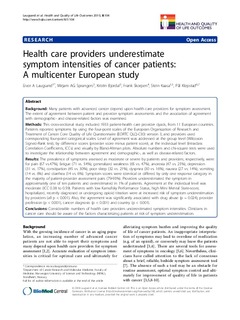Health care providers underestimate symptom intensities of cancer patients: A multicenter European study
Laugsand, Eivor Alette; Sprangers, Mirjam A. G.; Bjordal, Kristin; Skorpen, Frank; Kaasa, Stein; Klepstad, Pål
Journal article, Peer reviewed
Permanent lenke
http://hdl.handle.net/11250/2357737Utgivelsesdato
2010Metadata
Vis full innførselSamlinger
Sammendrag
Background: Many patients with advanced cancer depend upon health care providers for symptom assessment.
The extent of agreement between patient and provider symptom assessments and the association of agreement
with demographic- and disease-related factors was examined.
Methods: This cross-sectional study included 1933 patient-health care provider dyads, from 11 European countries.
Patients reported symptoms by using the four-point scales of the European Organization of Research and
Treatment of Cancer Core Quality of Life Questionnaire (EORTC QLQ-C30) version 3, and providers used
corresponding four-point categorical scales. Level of agreement was addressed at the group level (Wilcoxon
Signed-Rank test), by difference scores (provider score minus patient score), at the individual level (Intraclass
Correlation Coefficients, ICCs) and visually by Bland-Altman plots. Absolute numbers and chi-square tests were used
to investigate the relationship between agreement and demographic-, as well as disease-related factors.
Results: The prevalence of symptoms assessed as moderate or severe by patients and providers, respectively, were
for pain (67 vs.47%), fatigue (71 vs. 54%), generalized weakness (65 vs. 47%), anorexia (47 vs. 25%), depression
(31 vs. 17%), constipation (45 vs. 30%), poor sleep (32 vs. 21%), dyspnea (30 vs. 16%), nausea (27 vs. 14%), vomiting
(14 vs. 6%) and diarrhea (14 vs. 6%). Symptom scores were identical or differed by only one response category in
the majority of patient-provider assessment pairs (79-93%). Providers underestimated the symptom in
approximately one of ten patients and overestimated in 1% of patients. Agreement at the individual level was
moderate (ICC 0.38 to 0.59). Patients with low Karnofsky Performance Status, high Mini Mental State-score,
hospitalized, recently diagnosed or undergoing opioid titration were at increased risk of symptom underestimation
by providers (all p < 0.001). Also, the agreement was significantly associated with drug abuse (p = 0.024), provider
profession (p < 0.001), cancer diagnosis (p < 0.001) and country (p < 0.001).
Conclusions: Considerable numbers of health care providers underestimated symptom intensities. Clinicians in
cancer care should be aware of the factors characterizing patients at risk of symptom underestimation.
